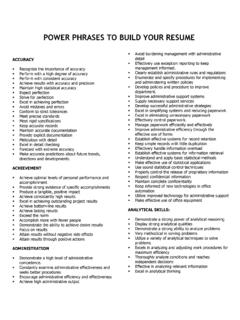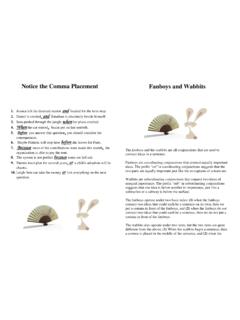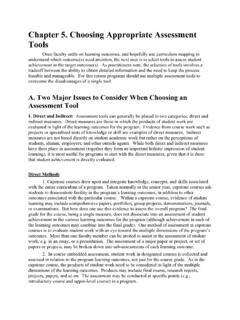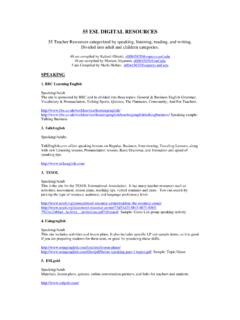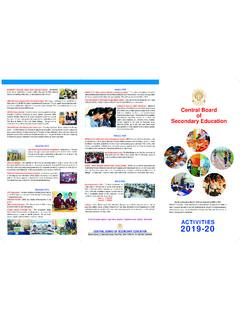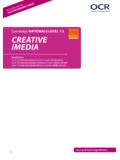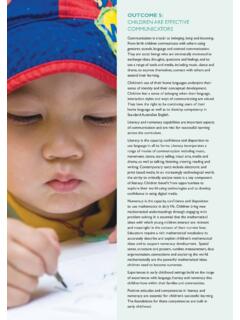Transcription of Transformative Education Contents
1 1 Transformative Education IU Southeast Academy of Diversity and Inclusive Education (ADIE) July 2012 Contents I. Why Teach With Transformative Education Theory? II. How Can I as a Faculty Member Foster Transformative Thinking? III. Strategies and Resources to Use in the Classroom IV. Stances of Transformative Learning V. Annotated Bibliography of Resources VI. Supplemental Resources I. Why Teach with Transformative Education Theory? Transformative learning gives adult learners the ability to think autonomously, that is, to think as individuals. It allows learners to develop their own sense of meaning in the world free from the accepted purposes, beliefs, judgments, values, and feelings that we received from our cultures, religions, family beliefs, personalities, and life experiences.
2 Autonomous thinking is vital for full participation in a democratic society as well as for moral decision making (Mezirow, 1997, p. 7); thus, it is the goal of higher Education to produce autonomous thinkers (Mezirow, 1997, p. 5). Transformative learning allows students and educators to develop genuine relationships in which the educator makes a difference in the students lives and feels a difference in his or her own life as well (Cranton, 2006, p. 8). Transformative learning allows adult learners to use the contexts of their formal learning experiences to construct and reconstruct personal meaning (Dirkx, 2006, p. 24). Adult learners will inevitably join the workforce after they complete their college Education , or more likely, while they are completing their college Education .
3 The identified learning needs of the workforce implicitly recognize the importance of autonomous learning (Mezirow, 1997, p. 7). For adults to truly take ownership of social and personal roles, being able to develop this self-authorship goes a long way towards helping our society and world to become a better place (TLT Website). 2 Transformative Education Theory supports the IU Southeast Strategic Objective , which states that IU Southeast will prepare students to function effectively in a culturally diverse and global community by infusing principles of diversity and equity throughout the curriculum. Transformative Education Theory supports the IU Southeast Mission Statement, which states that IU Southeast strives to provide high-quality educational programs and services that promote student learning and prepare students for productive citizenship in a diverse society, and to contribute to the intellectual, cultural , and economic development of the region ( IUS Strategic Plan).
4 BACK TO Contents II. How Can I as a Faculty Member Foster Transformative Thinking? Establish authentic, meaningful, and genuine relationships with students (Cranton, 2006) Create learning environments that promote self-directed learning, in which learners work in problem-solving groups and learn from one another by becoming aware and critical of their own and others assumptions (Mezirow, 1997). Help students engage emotions in the learning process (Dirkx, 2006). Create classroom norms that accept order, justice, and civility as well as respect and responsibility for helping each other learn (Mezirow, 1997, p. 11) Engage learners in classroom practices that assist in the development of critical reflection (Taylor, 2008, p.)
5 11) BACK TO Contents III. Strategies and Resources to Use in the Classroom There are several teaching strategies recommended by those that study the effectiveness of Transformative learning. Several recommendations are listed below. We hope you find them to be useful in your classroom. Oral/Verbal o Deliberation: collaborative process of discussing contested issues by considering various perspectives in order to form opinions and guide judgment International Debate Education Association University of Pittsburg Argument & Debate o Discussion: help students to gain interest in the material, correct misconceptions, and analyze information critically University of Pittsburg The Importance of Class Discussions Fostering Effective Classroom Discussions 3 o Speech: can be a powerful tool to use for purposes such as motivation, influence, persuasion, informing, translation, or simply ethos University of Pittsburg Speech Resources and Databases Speech Topics Help, Advice, & Ideas o Case Studies.
6 Presents authentic, concrete teaching problems for students to analyze National Center for Case Study Teaching in Science Vanderbilt University Center for Teaching Laboratory for Innovative Technology and Engineering Education Writing Case Studies A Manual Using Case Studies Teacher s Guide o Life Histories/Narratives/ storytelling /Critic al Incidents: gives learners the opportunity to understand and reflect on their own experiences as well as the experiences of others Narrative as a Teaching Strategy Instructional Strategies Online o Role Play/Simulations: instructor creates a world in which the learners interact with one another based on specific parameters set by the instructor; students experience the reality of the world and gather meaning from it Role-Playing as a Teaching Strategy Interactive Drama Role Playing in Online Education Group Process o Group Projects/Presentations: gives learners the opportunity to challenge assumptions and develop their own perspectives in relation to others Carnegie Mellon: Using Group Projects Effectively Planning Group Projects o Action Learning: learners are placed on teams and asked to solve a problem or issue.
7 Involves extensive reflection and dialogue as they work at a solution International Foundation for Action Learning o Collaborative Inquiry (CI): learners voluntarily participate in solving a problem or issue that is framed by the group with no outside interference (Yorks and Marsick, 2000, p. 266 as cited in Baumgartner, 2001, p. 19) NYU Wagner: Collaborative Inquiry Process o Service Learning: gives learners the opportunity to participate in social action and help others Carnegie Mellon: Service Learning Iowa State University 4 Individual o Reading: has the potential to bring about emotional experiences that foster deeper engagement of the self with the learning process o Personal Journaling: allows students to make observations and reflect on their learning o Writing: gives learners the opportunity to make connects and respond which allows them to see themselves as thinkers and knowledge seekers Carnegie Mellon.
8 Incorporating Writing into Your Course Harvard Writing Project University of North Carolina at Chapel Hill Writing Center o Concept Mapping: creating a form of a web diagram that is useful in exploring knowledge as well as gathering and sharing information Instructional Strategies Online Concept Map Brigham Young University o Discovery/Inquire Based Learning: specific observations, case studies, or problems are examined and theories are developed based on the solutions Inquiry Based Learning Penn State Focus on Inquiry o Learning Contracts: gives learners individualized learning goals and permits individual pacing; allows instructor to relinquish some power and develop authentic relationships with learners Using Learning Contracts in the College Classroom Lecturing is often an appropriate method of teaching in higher Education classrooms.
9 After all, university professors were hired as subject matter experts, so why would students not want the opportunity to learn directly from an expert in the field? Although lecturing is necessary in many instances, it is not always utilized in a way that is conducive to foster Transformative learning. Here are 50 Alternatives to Lecturing. Try using a few in your classroom this semester. BACK TO Contents IV. Stances of Transformative Learning Below appear a number of stances within Transformational Learning Theory evident in the literature, each with its own focus, approach, and purpose. They illustrate the richness and adaptability as a more specific entry into strategies for instructional use. cultural -Spiritual o Focus of the Theory Focuses on how learners construct knowledge (narratives) as part of the Transformative learning experience (Taylor, 2008, p.)
10 8) Concerned with the connections between individuals and social structures (Tisdell, 2005 as cited in Taylor, 2008, p. 8) 5 o Approach Engaging storytelling on a personal and social level through group inquiry (Taylor, 2008, p. 9) Teacher takes on the role of collaborator with an emphasis on group inquiry and narrative reasoning (Taylor, 2008, p. 9) o Purpose Helps learners develop cross- cultural relationships as well as spiritual awareness (Taylor, 2008, p. 9) Neurobiological o Focus of the Theory Based on the discovery that the brain structure actually changes during the learning process (Taylor, 2008, p. 8) Learning is seen as volitional, curiosity-based, discovery-driven, and mentor-assisted (Janik, 2005 as cited in Taylor, 2008, p.
